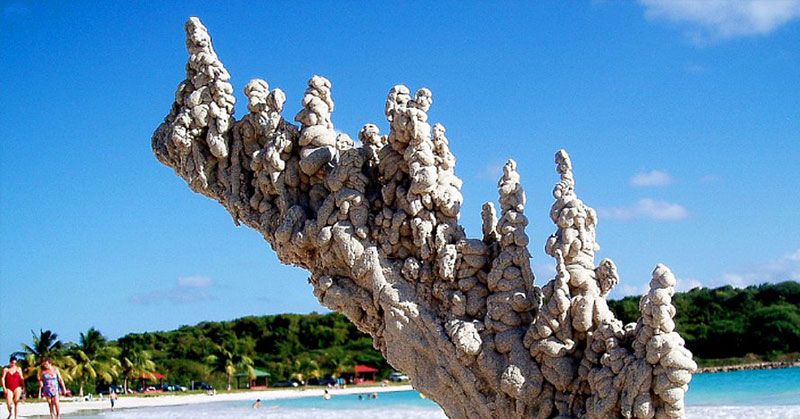Lightning striking the ground is certainly not a scenario many people would want to witness in their immediate environment, but if watching it from afar, nature compensates for the momentary terror with a few magic tricks.
When lightning strikes sand, soil, rock or any surface containing an abundance of silica, fulgurites are formed. They are tube-shaped glassy deposits formed when a temperature as high as 1,800 degrees Celsius (3,270 degrees Fahrenheit) dissolves the atomic structure of sand or rock to form something much “cooler”.
In a split second, the intense heat from lightning would melt the silica and fuse it back with other minerals and elements in the sand, altering the natural structure and forming glassy deposits on the surface [1]. Other powerful heat sources that can produce the same amount of heat or even higher would also cause the formation of fulgurites.
Fulgurite composition
The word fulgurite was coined from the Latin word fulgur, which means “thunderbolt”.
Fulgurites are covered on the exterior by rough sand or rock particles. On the interior, they are extremely smooth hollow tubes and are usually filled by fine bubbles of vapor, caught up in the cooling process.
There are two types of fulgurites. Sand fulgurites are formed when lightning strikes sand. They are the more common type, usually seen in beaches and deserts. They can stretch as long as ten feet on the surface and run far deeper into the ground.
Rock fulgurites are glassy stones on the surface of rocks, mostly found on Mountains and natural spring rocks. They don’t have the same sandy exteriors but are usually covered by a rocky grit.
Silica, typically found as silicon oxide, (SiO2) is a compound made of a grid of silicon atoms bound by oxygen atoms, two of the most abundant elements on earth (sand and earth) [1]. SiO2 has various varieties called mineraloids. Quartz (the most abundant), tridymite, cristobalite, and lechatelierite and a few others. Lechatelierite is the variety of silica most active in the formation of fulgurites.
Understanding lightning from the study of fulgurites
Sometimes, fulgurites may appear as if they were hand-carved and set in sand. The most beautiful ones look like Greek figurines piled on top of each other. Fulgurites can run as deep as 50 feet below the surface upon which the bolt struck. This phenomenon is evidence of the extreme power of one bolt of lightning.
Scientists have never fully understood how lightning works. However, the mechanism of formation of fulgurites, also called petrified lightning, promises to be of great help in this area of study. Jiangzhi Chen, an applied physicist at the University of Pennsylvania says that an analysis of the fine vapor bubbles stuck in the fulgurite can reveal how hot the elements got before the final formation. This may be able to reveal more insight as to how lightning really works.
“[When lightning strikes], only a fraction of the energy is actually transmitted to the rock, Those impact events are relatively to difficult to study, but lightning hitting a target is relatively easy to find,” Chen said to Live Science [3].
Chen believes that further analysis of the rock would provide groundbreaking information on the science of lightning. The frequencies of light reflecting off the crystal would allow the scientists to understand the composition of the fulgurite, which is not the same as the original composition of the parent rock.
Also, a knowledge of the formation of bubbles at different temperatures is key to calculating an approximate temperature to which the rock was heated during the process. It would stay hot for a while before cooling to form the glass deposits. This cooling duration is also not known and can be estimated from the analysis.
Sources
- Editor. Fulgurite: When lightning strikes sand, magic is formed. Geology In. https://www.geologyin.com/2014/06/amazing-fulgurites.html. Retrieved 16-08-19
- Editors. Fulgurite. Britannica. https://www.britannica.com/science/fulgurite. Retrieved 16-08-19
- Ghose, Tia. Zap! ‘Petrified Lightning’ Could Reveal the Shocking Heat of the Strikes. Live Science. https://www.livescience.com/57237-petrified-lightning-reveals-energy-of-strikes.html. Retrieved 16-08-19

